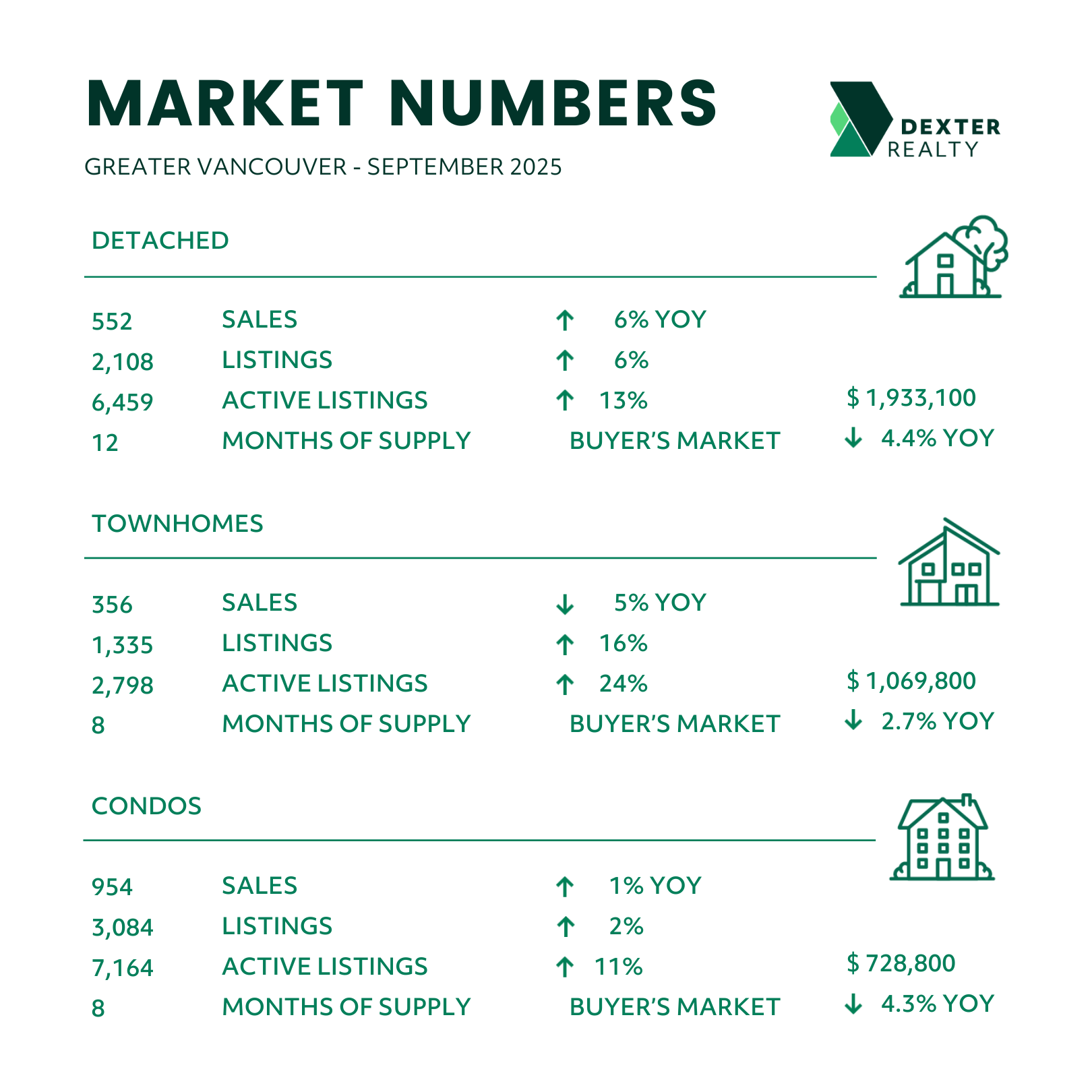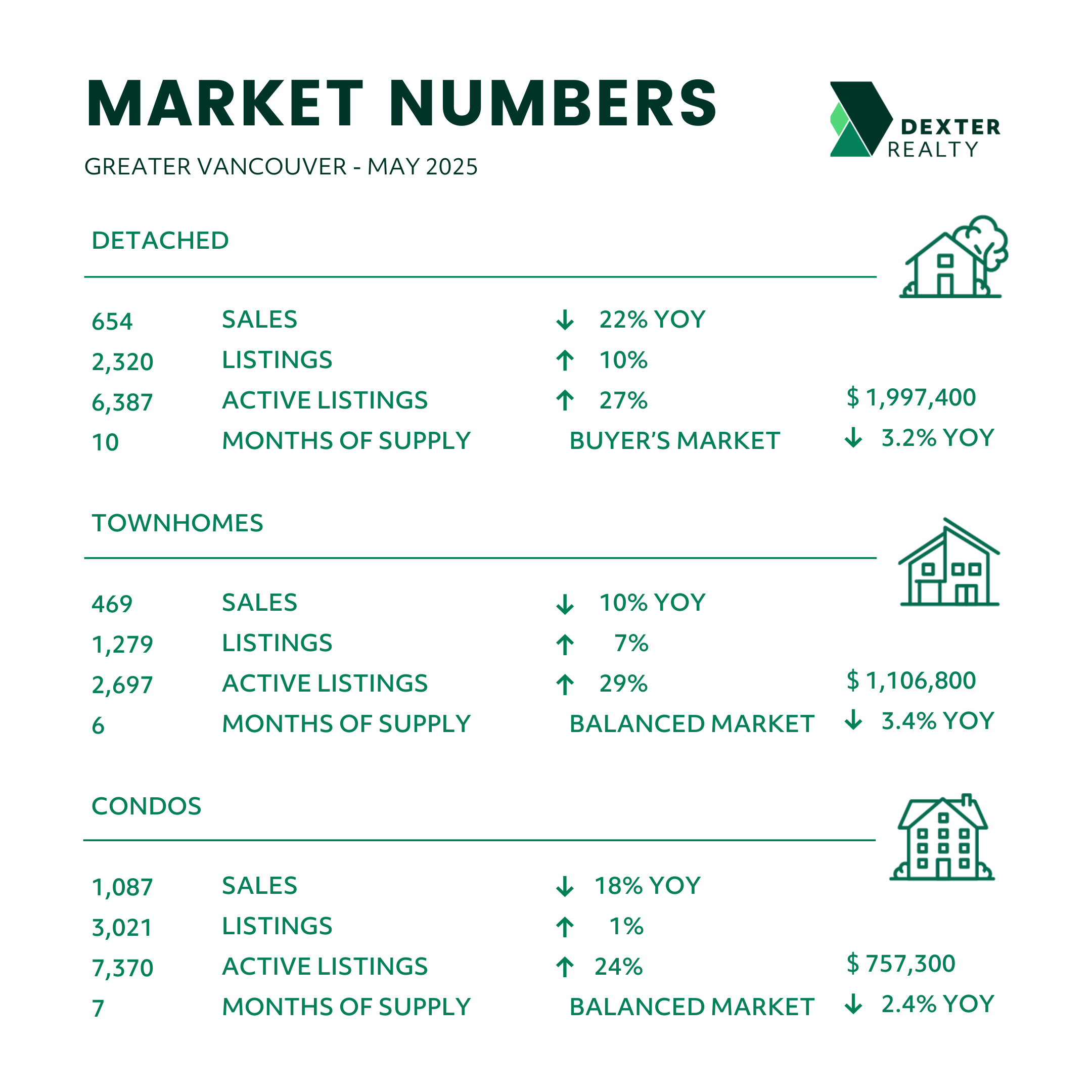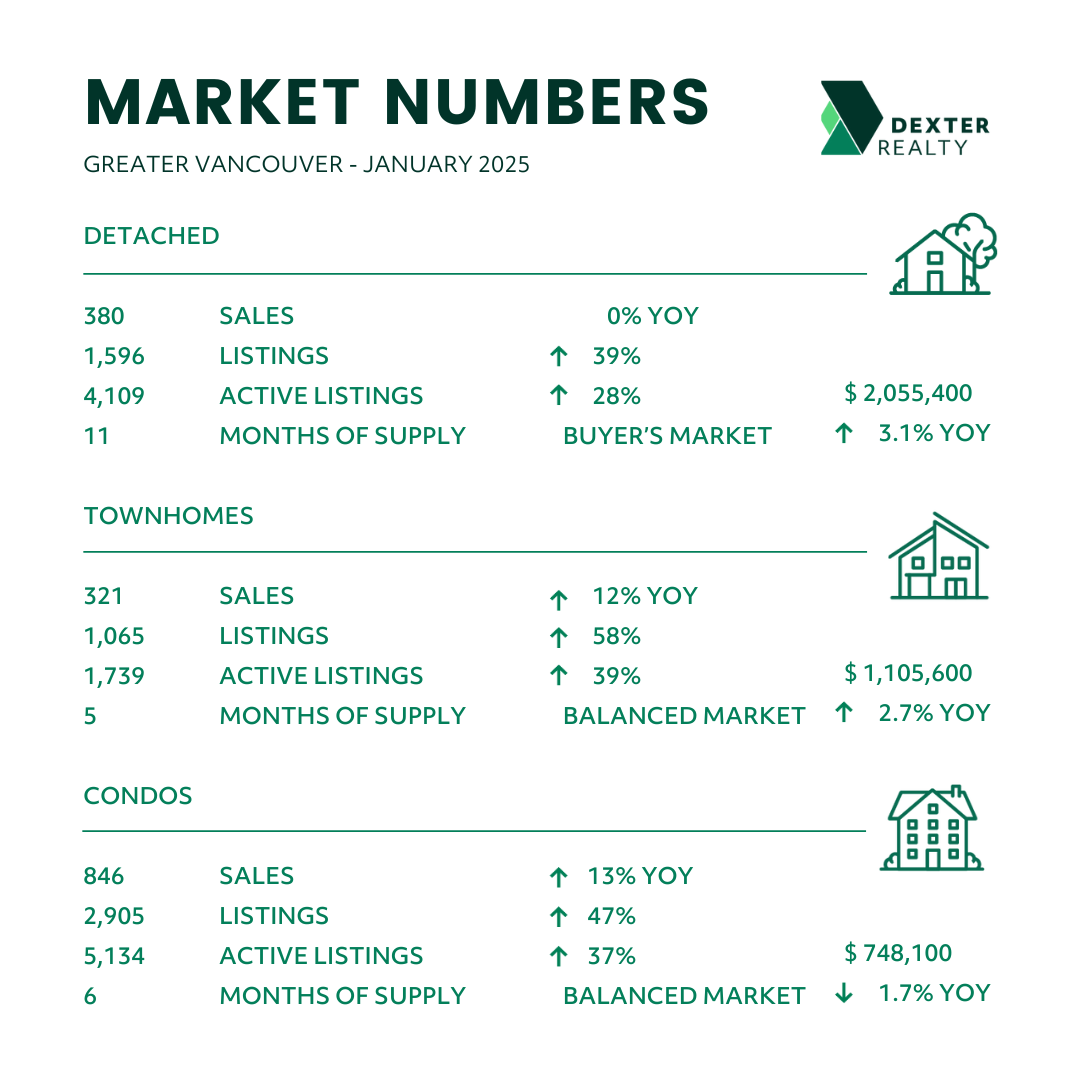Highlights of Dexter’s September 2025 report
Buyer’s advantage continues
Listings pile back on in September
At least we beat September 2024 sales
The cuts continue from the Bank of Canada
The heat of the summer market cooled in September – but that is to be expected. Don’t let the headlines fool you when you read that September sales in Metro Vancouver were less then August. That’s typical. September carries forwards the dog days of summer as the lack of activity in August translates to fewer sales reported in September. And as everyone focusses on getting back to routines to start September, real estate takes a back seat. But that could change as we move through the remainder of 2025 with the Bank of Canada stepping out of the shadows and putting a rate drop into the mix in September which lowered variable rate mortgages. Will there be more to finish the year? Likely, but when depends on the economic data released this month.
September closed the books on a transitional quarter in Metro Vancouver real estate, a month where the market showed resilience amid shifting conditions. While overall sales softened compared to the swifter pace of the spring and early summer, inventory expanded again, giving buyers continued choice. For sellers, the takeaway isn’t necessarily negative either—while pricing has edged lower, the depth of demand in certain submarkets and the surge of new listings suggest that activity is far from stalling out. Instead, we’re watching a marketplace realign itself after an extended stretch of volatility.
Greater Vancouver – The Big Picture
Across Greater Vancouver, September registered 1,875 sales, slipping 4% from August and off 18% compared to July. But context matters: sales were still higher than September 2024, and only marginally below September 2023. On the supply side, the changes were striking. Active listings reached 17,079, a 14% jump from last year and 5% above August. Even more telling, September brought in 6,631 new listings, a 54% leap month-over-month, and one of the strongest listing surges in years to enter the fall market. But were they all new?
This supply dynamic matters. Months of inventory now sit at nine, technically a buyer’s market, but one that comes with an important nuance: choice has returned, and that encourages engagement. Buyers who have been sitting on the sidelines now have room to negotiate, while sellers who adapt quickly to pricing and marketing strategies are still finding success. The sales-to-listings ratio, at 28%, shows the market activity lagged below August’s 45% ratio, but it remains healthier than many downturn periods of the past.
Greater Vancouver sales in September were 20% below the 10-year average, just off August at 19% below the 10-year average, but an improvement from June at 26% below the 10-year average and May at 30% below the 10-year average. The market is trying its best to get to average and expect October to get closer than we’ve seen this year.
Greater Vancouver townhome sales in September were surprisingly down 5% after being up 10% compared to August last year, while condos sales were up 1% after being down 5% from the previous year in August and in July and June at 16% down year-over-year. Detached sales continued its positive trajectory at 6% above last year to go with August at 12% year-over-year.
Back Above 17,000
Inventory ramped up again. Active listings finished September at 17,079, up 14% from last year’s 14,932, and a jump of 5% from August’s 16,242. While a seemingly significant increase, it was less than the month-over-month gain seen in September 2024 and 2023 likely due to a recycling of listings coming off and back on at lower price points. Meanwhile, new listings jumped again in September with 6,631 coming on the market in September, of course not all being new as previously identified. Price adjustments are commonplace in the market and show up many times as a new listing.
The region remains firmly in this buyer’s market. Months of supply climbed up to 9, the first time it’s been that high since the end of 2018 and start of 2019. Buyers certainly need to take note of that.
The number of new listings in September were 20% above the 10-year average after August was only 1% above the 10-year average.
Vancouver’s Westside produced 316 sales in September, down from August but nearly identical to last year’s levels. Active listings edged just above 3,100, essentially flat year-over-year, while new listings exploded up 68% from August. That kind of surge is a sign that sellers are re-engaging, confident enough in the long-term appeal of Vancouver’s premier submarket to list now or adjust already active listings to an improved price for buyers.
While the months of supply moved up to 10, clearly favouring buyers, the sales-to-listings ratio of 24% still shows that transactions are happening albeit at a slower pace.
Over on Vancouver’s Eastside, there were 208 sales in September, down just 5% from August and very close to September 2024 levels. Active listings reached 1,740, 14% higher than a year ago, and new listings jumped a remarkable 75% compared to August. This flood of inventory helped push months of supply to 8, technically a buyer’s market but closer to balance than many other areas.
Resilience in North Vancouver stood out in September as one of the few bright spots on the sales front. With 159 sales, transactions rose 14% from August and 10% from September 2024, even though they remained lower than peak summer volumes. Inventory climbed to 1,072 active listings, up sharply from last year, while new listings nearly doubled month-over-month.
Despite this, months of supply stayed at 7—a balanced market reading which also shows it being the only city other than Squamish with a positive year-over-year benchmark price reading.
Richmond continues to reset with 191 sales in September, down from August and well below last year, but inventory levels tell a bigger story. Active listings climbed to 2,210, up 27% from 2024, while new listings rose 28% from August. That pushed months of supply to 12, clearly tilting the market to buyers. For buyers, this creates leverage; for sellers, it emphasizes the need for accurate pricing. The market is not silent, but it is selective, rewarding homes that are well-positioned.
The Suburb Story
Burnaby and New Westminster both outperformed their fellow municipalities to the east with month-over-month growth in sales not seen elsewhere. The difference in markets is an important story for buyers that shows they really need to do their homework when comparing market trends. One city’s trend does not make a market elsewhere.
Delta – Positive Momentum
Delta markets, Ladner and Tsawwassen, delivered some of the strongest performances in September. Ladner’s sales rose 31% from August and an impressive 55% compared to 2024. Months of supply dropped to just 5, a balanced level, but prices were down 4.2% year-over-year.
Tsawwassen saw stable sales compared to August, higher listings, and a healthy 37% sales-to-listings ratio. Despite price declines of 5.1% year-over-year, the market is showing renewed momentum as buyers are drawn to the value relative to Richmond and Vancouver.
Fraser Valley
The Fraser Valley mirrored many of the Greater Vancouver trends but with its own resilience. Sales rose 3% month-over-month from 931 to 962 in September, even if they were slightly below last year’s September total 982 (down 2%). New listings climbed 23%, and active inventory rose 1% compared to August, keeping the market relatively balanced. Months of supply remained at 11, and while average prices softened 2% month-over-month and 4% year-over-year, the adjustments remain controlled.
The Takeaway – A Market of Opportunities
September’s real estate numbers confirm what many on the ground are already seeing: Metro Vancouver is not in retreat, it’s in recalibration. Sales volumes may have temporarily cooled from the heights of spring and early summer, but new listings have surged, creating a far more balanced environment. Prices are adjusting modestly, but the declines are far from catastrophic, particularly when compared to the rapid gains of past cycles.
For buyers, this is the most opportunity-rich market in years, with choice across virtually every submarket and negotiability returning to the table, be it resale or brand-new homes especially. For sellers, the message is about strategy: homes that are well-prepared, priced in line with today’s sales, and marketed effectively are still transacting.
We may not see this kind of opportunity for years. And with developers selling off existing stock with few new developments coming online, expect to see a shortage of new homes in the coming years.
The next few months will likely see this balance persist. Interest rate stability, buyer choice, and steady demand are all factors suggesting that while we are in a buyer’s market by definition, it is one characterized more by opportunity than by distress. In other words, Greater Vancouver real estate is moving into a more sustainable gear.
Here’s a summary of the numbers:
Greater Vancouver: Total Units Sold in September were 1,875 down from 1,959 (4%) in August, down from 2,286 (18%) in July, down from 2,181 (14%) in June, up from 1,852 (1%) in September 2024, and down from 1,926 (3%) in September 2023; Active Listings were at 17,079 at month end compared to 14,932 at that time last year (up 14%) and 16,242 at the end of August (up 5%); the 6,631 New Listings in September were up 54% compared to August, up 16% compared to July, up 3% compared to June, up 6% compared to September 2024, and up 19% compared to September 2023. Month’s supply of total residential listings is up to 9 month’s supply from 8 (buyer’s market conditions) and sales to listings ratio of 28% compared to 45% in August, 30% in September 2024, and 35% in September 2023.
Month-over-month, the house price index is down 0.7% and in the last 12 months down 3.2%.
Vancouver Westside: Total Units Sold in September were 316 down from 381 (17%) in August, down from 396 (20%) in July, down from 417 (24%) in June, up from 312 (1%) in September 2024, and down from 338 (7%) in September 2023; Active Listings were at 3,188 at month end compared to 3,174 at that time last year (up 0.5%) and 3,105 at the end of August (up 3%); the 1,293 New Listings in September were up 68% compared to August, up 26% compared to July, up 7% compared to June, down 1% compared to September 2024, and up 12% compared to September 2023. Month’s supply of total residential listings is up to 10 month’s supply from 8 (buyer’s market conditions) and sales to listings ratio of 24% compared to 50% in August, 24% in September 2024, and 29% in September 2023.
Month-over-month, the house price index is down 0.4% and in the last 12 months down 2.9%.
Vancouver East Side: Total Units Sold in September were 208 down from 219 (5%) in August, down from 242 (14%) in July, down from 267 (20%) in June, down from 211 (2%) in September 2024, and up from 192 (8%) in September 2023; Active Listings were at 1,740 at month end compared to 1,529 at that time last year (up 14%) and 1,599 at the end of August (up 9%); the 807 New Listings in September were up 75% compared to August, up 33% compared to July, up 8% compared to June, up 5% compared to September 2024, and up 29% compared to September 2023. Month’s supply of total residential listings is up to 8 month’s supply from 7 (buyer’s market conditions) and sales to listings ratio of 26% compared to 48% in August, 27% in September 2024, and 31% in September 2023.
Month-over-month, the house price index is down 1.2% and in the last 12 months down 2.5%.
North Vancouver: Total Units Sold in September were 159 up from 139 (14%) in August, down from 190 (16%) in July, down from 200 (20%) in June, up from 144 (10%) in September 2024, and down from 169 (6%) in September 2023; Active Listings were at 1,072 at month end compared to 856 at that time last year (up 25%) and 938 at the end of August (up 14%); the 605 New Listings in September were up 99% compared to August, up 30% compared to July, up 13% compared to June, up 11% compared to September 2024, and up 26% compared to September 2023. Month’s supply of total residential listings is steady at 7 month’s supply (balanced market conditions) and sales to listings ratio of 26% compared to 46% in August, 27% in September 2024, and 35% in September 2023.
Month-over-month, the house price index is down 0.3% and in the last 12 months up 0.6%.
West Vancouver: Total Units Sold in September were 52 up from 53 (2%) in August, down from 62 (16%) in July, down from 53 (2%) in June, up from 45 (16%) in September 2024, and down from 53 (2%) in September 2023; Active Listings were at 781 at month end compared to 724 at that time last year (up 8%) and 717 at the end of August (up 9%); the 278 New Listings in September were up 99% compared to August, up 32% compared to July, up 22% compared to June, up 17% compared to September 2024, and up 10% compared to September 2023. Month’s supply of total residential listings is down to 15 month’s supply from 17 (buyer’s market conditions) and sales to listings ratio of 19% compared to 31% in August, 19% in September 2024, and 21% in September 2023.
Month-over-month, the house price index is down 2.1% but in the last 12 months down 6.7%.
Richmond: Total Units Sold in September were 191 down from 223 (14%) in August, down from 241 (21%) in July, down from 243 (21%) in June, down from 197 (3%) in September 2024, and down from 256 (25%) in September 2023; Active Listings were at 2,210 at month end compared to 1,736 at that time last year (up 27%) and 2,129 at the end of August (up 4%); the 711 New Listings in September were up 28% compared to August, up 11% compared to July, down 3% compared to June, up 13% compared to September 2024, and up 17% compared to September 2023. Month’s supply of total residential listings is up to 12 month’s supply from 10 (buyer’s market conditions) and sales to listings ratio of 27% compared to 40% in August, 31% in September 2024, and 43% in September 2023.
Month-over-month, the house price index is down 1.0% and in the last 12 months down 5.7%.
Burnaby East: Total Units Sold in September were 34 up from 21 (62%) in August, up from 30 (13%) in July, up from 22 (55%) in June, up from 29 (17%) in September 2024, and up from 18 (89%) in September 2023; Active Listings were at 219 at month end compared to 148 at that time last year (up 48%) and 229 at the end of August (down 4%); the 96 New Listings in September were up 50% compared to August, up 16% compared to July, up 20% compared to June, up 43% compared to September 2024, and up 96% compared to September 2023. Month’s supply of total residential listings is down to 6% month’s supply from 8 (balanced market conditions) and sales to listings ratio of 35% compared to 33% in August, 43% in September 2024, and 37% in September 2023.
Month-over-month, the house price index is down 3.3% and in the last 12 months down 6.6%.
Burnaby North: Total Units Sold in September were 137 up from 115 (19%) in August, down from 164 (16%) in July, up from 117 (17%) in June, up from 122 (12%) in September 2024, and up from 113 (21%) in September 2023; Active Listings were at 908 at month end compared to 839 at that time last year (up 8%) and 883 at the end of August (up 3%); the 380 New Listings in September were up 48% compared to August, up 3% compared to July, up 6% compared to June, up 12% compared to September 2024, and up 25% compared to September 2023. Month’s supply of total residential listings is down to 7 month’s supply from 8 (balanced market conditions) and sales to listings ratio of 36% compared to 45% in August, 36% in September 2024, and 37% in September 2023.
Month-over-month, the house price index is down 0.7% and in the last 12 months down 4.3%.
Burnaby South: Total Units Sold in September were 96 down from 103 (7%) in August, down from 142 (32%) in July, down from 110 (13%) in June, down from 114 (16%) in September 2024, and down from 126 (24%) in September 2023; Active Listings were at 841 at month end compared to 694 at that time last year (up 26%) and 811 at the end of August (up 4%); the 304 New Listings in September were up 47% compared to August, up 3% compared to July, down 2% compared to June, down 8% compared to September 2024, and up 9% compared to September 2023. Month’s supply of total residential listings is up to 9 month’s supply from 8 (buyer’s market conditions) and sales to listings ratio of 32% compared to 50% in August, 34% in September 2024, and 45% in September 2023.
Month-over-month, the house price index is down 1.0% and in the last 12 months down 1.7%.
New Westminster: Total Units Sold in September were 84 up from 73 (15%) in August, down from 99 (15%) in July, up from 71 (18%) in June, up from 73 (15%) in September 2024, and up from 72 (17%) in September 2023; Active Listings were at 626 at month end compared to 468 at that time last year (up 34%) and 607 at the end of August (up 3%); the 267 New Listings in September were up 42% compared to August, up 14% compared to July, down 1% compared to June, up 10% compared to September 2024, and up 54% compared to September 2023. Month’s supply of total residential listings is down to 7 month’s supply from 8 (balanced market conditions) and sales to listings ratio of 31% compared to 39% in August, 30% in September 2024, and 42% in September 2023.
Month-over-month, the house price index is down 1.4% and in the last 12 months down 5.8%.
Coquitlam: Total Units Sold in September were 167 up from 164 (2%) in August, down from 205 (19%) in July, down from 171 (2%) in June, up from 155 (8%) in September 2024, and down from 170 (2%) in September 2023; Active Listings were at 1,322 at month end compared to 1,146 at that time last year (up 15%) and 1,280 at the end of August (up 3%); the 568 New Listings in September were up 35% compared to August, up 13% compared to July, the same as June, up 11% compared to September 2024, and up 29% compared to September 2023. Month’s supply of total residential listings is down to 7 month’s supply from 8 (balanced market conditions) and sales to listings ratio of 34% compared to 39% in August, 30% in September 2024, and 38% in September 2023.
Month-over-month, the house price index is down 1.0% and in the last 12 months down 4.2%.
Port Moody: Total Units Sold in September were 46 the same as August, down from 66 (30%) in July, down from 48 (4%) in June, down from 61 (25%) in September 2024, and up from 44 (5%) in September 2023; Active Listings were at 390 at month end compared to 251 at that time last year (up 55%) and 332 at the end of August (up 17%); the 191 New Listings in September were up 125% compared to August, up 19% compared to July, up 18% compared to June, up 34% compared to September 2024, and up 84% compared to September 2023. Month’s supply of total residential listings is up to 8 month’s supply from 7 (buyer’s market conditions) and sales to listings ratio of 24% compared to 54% in August, 43% in September 2024, and 42% in September 2023.
Month-over-month, the house price index is down 1.0% and in the last 12 months down 5.9%.
Port Coquitlam: Total Units Sold in September were 45 down from 46 (2%) in August, down from 85 (47%) in July, down from 58 (22%) in June, down from 52 (13%) in September 2024, and down from 65 (31%) in September 2023; Active Listings were at 394 at month end compared to 358 at that time last year (up 10%) and 354 at the end of August (up 11%); the 182 New Listings in September were up 50% compared to August, up 23% compared to July, up 2% compared to June, up 6% compared to September 2024, and up 29% compared to September 2023. Month’s supply of total residential listings is up to 9 month’s supply from 8 (buyer’s market conditions) and sales to listings ratio of 25% compared to 38% in August, 28% in September 2024, and 47% in September 2023.
Month-over-month, the house price index is down 0.9% and in the last 12 months down 2.8%.
Pitt Meadows: Total Units Sold in September were 15 down from 19 (20%) in August, down from 25 (40%) in July, down from 26 (42%) in June, down from 24 (4%) in September 2024, and down from 24 (37%) in September 2023; Active Listings were at 151 at month end compared to 125 at that time last year (up 20%) and 137 at the end of August (up 10%); the 52 New Listings in September were up 16% compared to August, down 16% compared to July, up 2% compared to June, down 25% compared to September 2024, and down 4% compared to September 2023. Month’s supply of total residential listings is up to 10 month’s supply from 7 (buyer’s market conditions) and sales to listings ratio of 28% compared to 42% in August, 34% in September 2024, and 44% in September 2023.
Month-over-month, the house price index is down 0.2% and in the last 12 months down 2.5%.
Maple Ridge: Total Units Sold in September were 97 down from 128 (24%) in August, down from 122 (20%) in July, down from 122 (20%) in June, down from 114 (15%) in September 2024, and down from 108 (10%) in September 2023; Active Listings were at 985 at month end compared to 887 at that time last year (up 11%) and 962 at the end of August (up 2%); the 329 New Listings in September were up 37% compared to August, down 7% compared to July, down 11% compared to June, down 4% compared to September 2024, and down 9% compared to September 2023. Month’s supply of total residential listings is up to 10 month’s supply from 8 (buyer’s market conditions) and sales to listings ratio of 29% compared to 53% in August, 33% in September 2024, and 30% in September 2023.
Month-over-month, the house price index is down 0.8% and in the last 12 months down 3.4%.
Ladner: Total Units Sold in September were 34 up from 26 (31%) in August, down from 36 (6%) in July, down from 35 (3%) in June, up from 22 (55%) in September 2024, and up from 26 (31%) in September 2023; Active Listings were at 168 at month end compared to 136 at that time last year (up 23%) and 174 at the end of August (down 3%); the 72 New Listings in September were up 41% compared to August, the same as July and June, down 1% compared to September 2024, and up 11% compared to September 2023. Month’s supply of total residential listings is down to 5 month’s supply from 7 (balanced market conditions) and sales to listings ratio of 47% compared to 51% in August, 30% in September 2024, and 40% in September 2023.
Month-over-month, the house price index is down 0.5% and in the last 12 months down 4.2%.
Tsawwassen: Total Units Sold in September were 38 down from 39 (3%) in August, up from 30 (27%) in July, down from 55 (31%) in June, up from 34 (11%) in September 2024, and down from 42 (10%) in September 2023; Active Listings were at 329 at month end compared to 215 at that time last year (up 53%) and 325 at the end of August (up 1%); the 102 New Listings in September were up 26% compared to August, down 10% compared to July, down 10% compared to June, up 28% compared to September 2024, and up 38% compared to September 2023. Month’s supply of total residential listings is up to 9 month’s supply from 8 (buyer’s market conditions) and sales to listings ratio of 37% compared to 48% in August, 43% in September 2024, and 57% in September 2023.
Month-over-month, the house price index is up 0.7% and in the last 12 months down 5.1%.
Fraser Valley: Sales in September were up 3% at 962 compared to August at 931 and were down 2% from September 2024 at 982. New listings were up 23% at 3,447 from August at 2,793 and up 3% from September 2024 at 3,352. The average price of $986,674 was down 2% month-over-month and was down 4.0% year-over-year. Active listings were up 1% to 10,583 compared to last month at 10,445 and up 10% from September 2024 at 9,045. Month’s supply of total residential listings remained at 11 months (buyer’s market conditions).
Month-over-month, the house price index is down 1.0% and in the last 12 months down 5.4%.




















